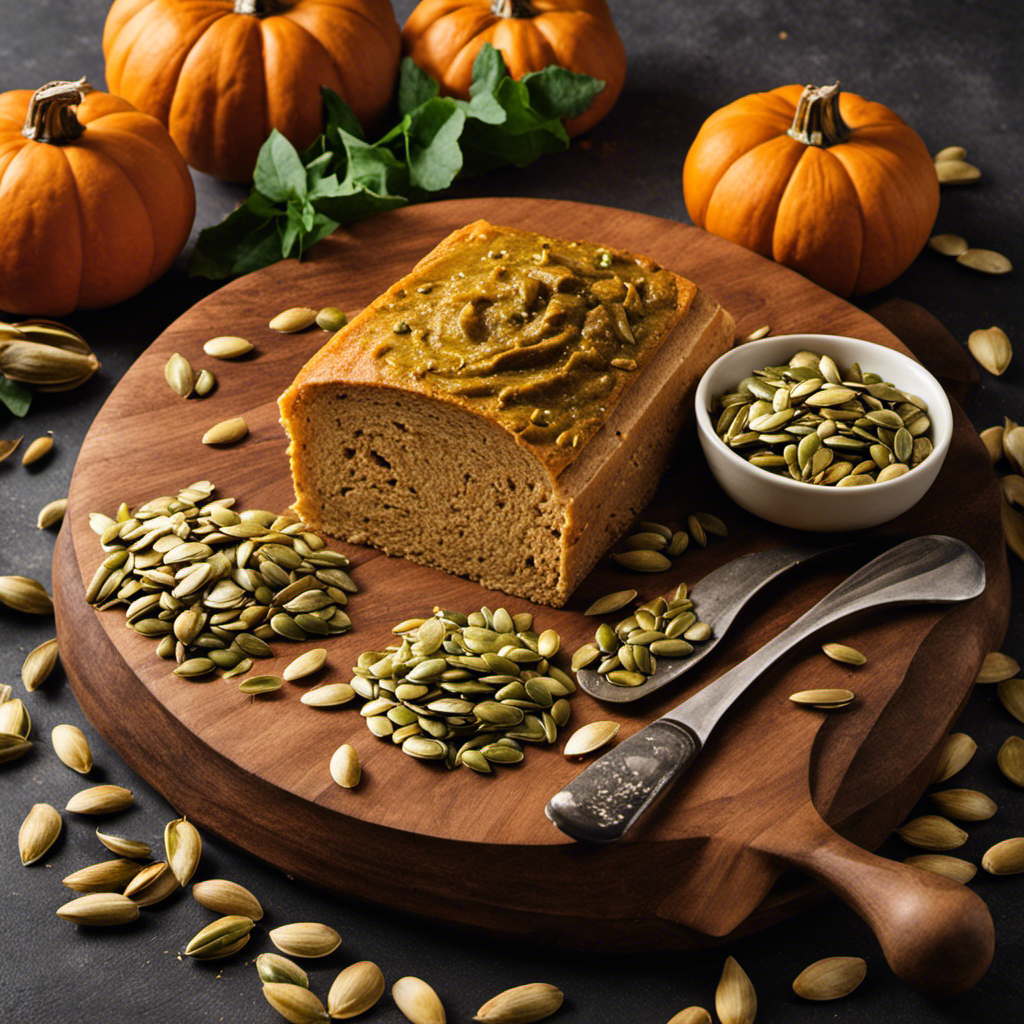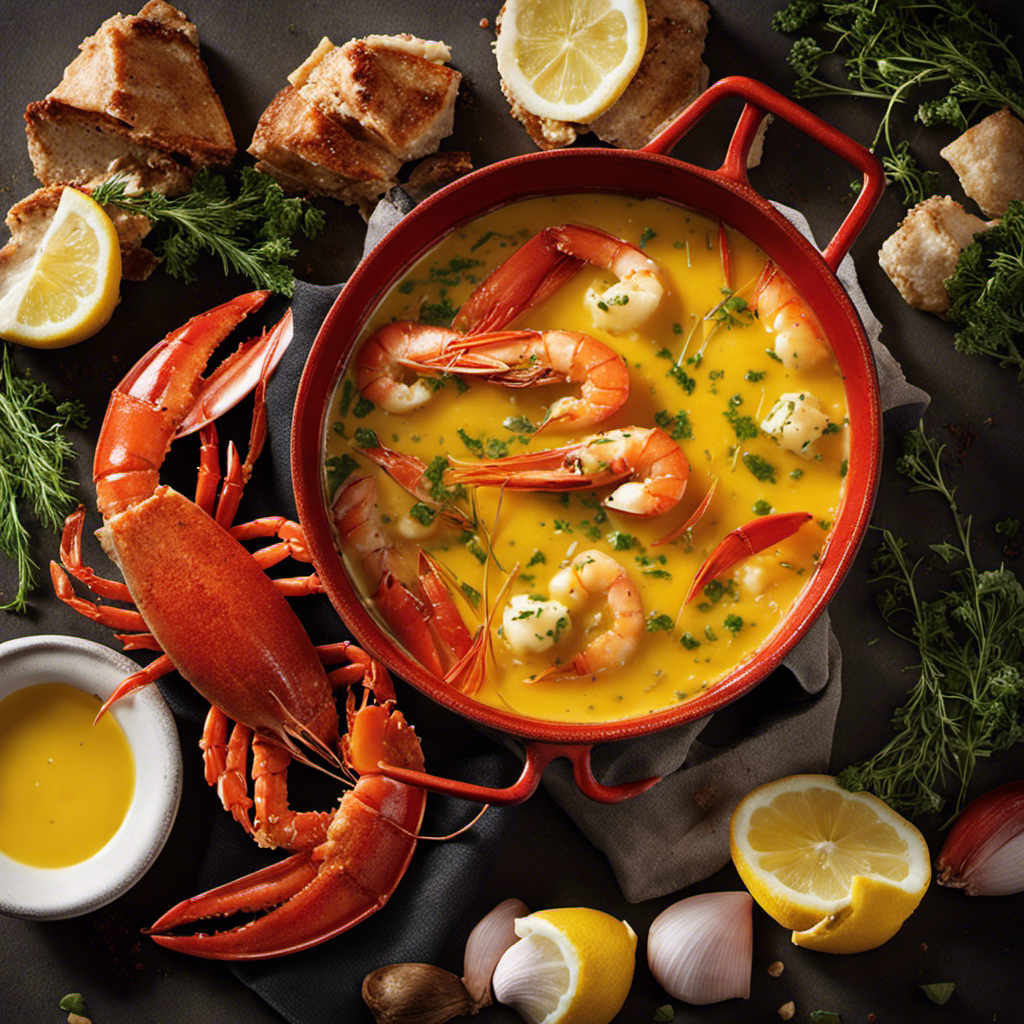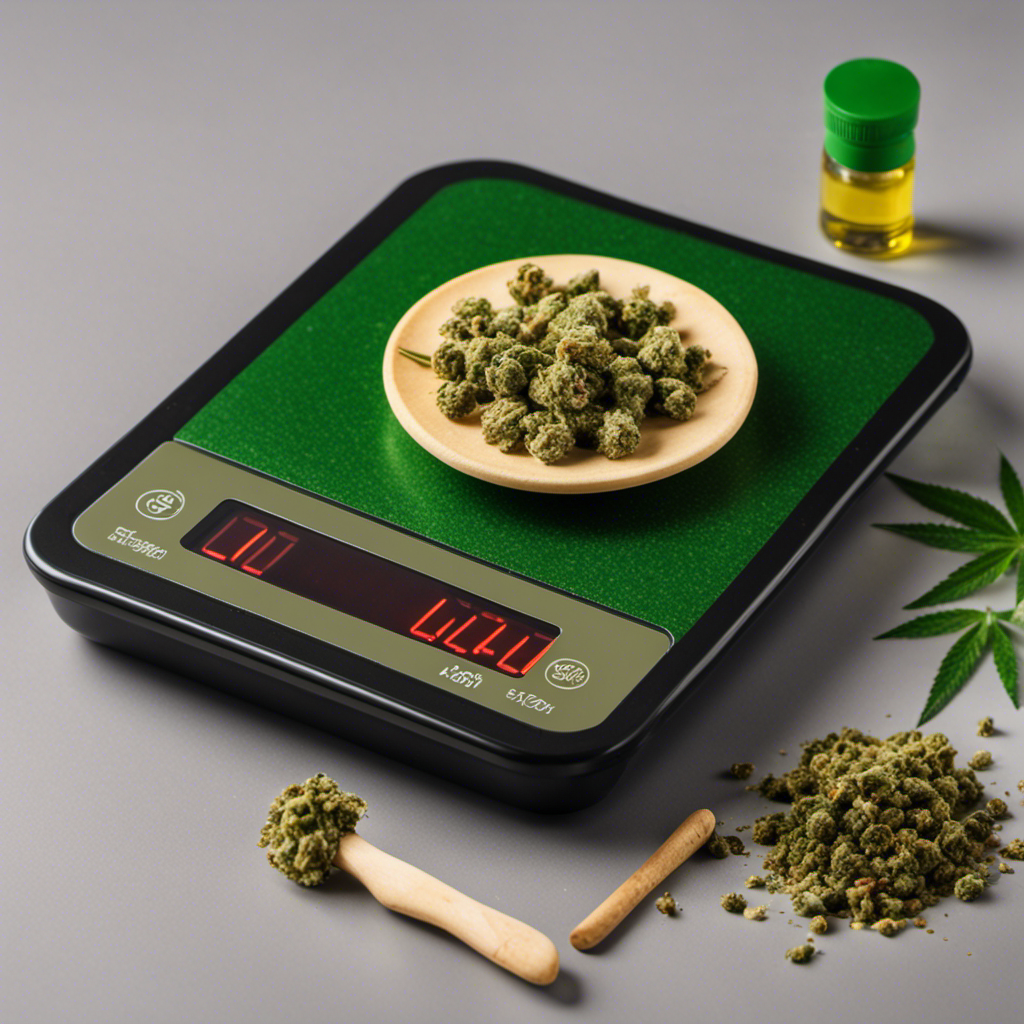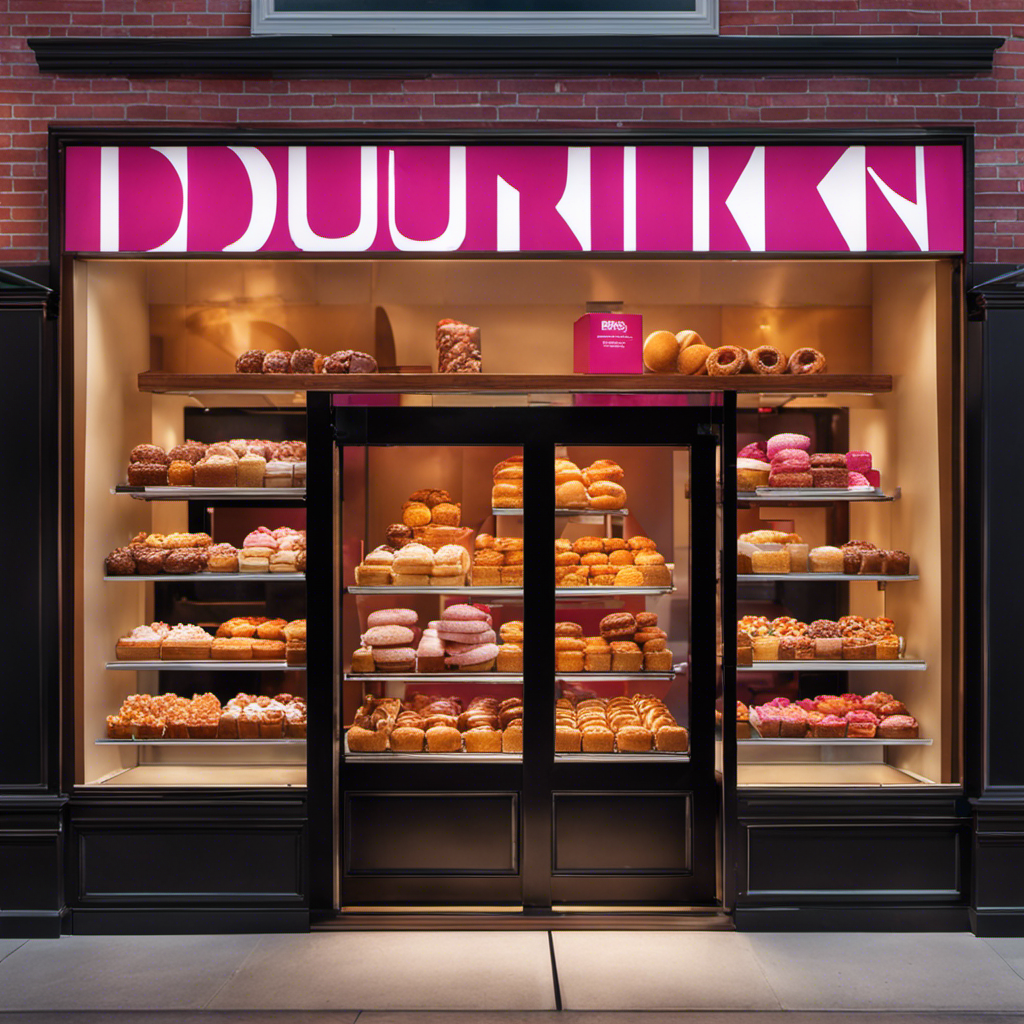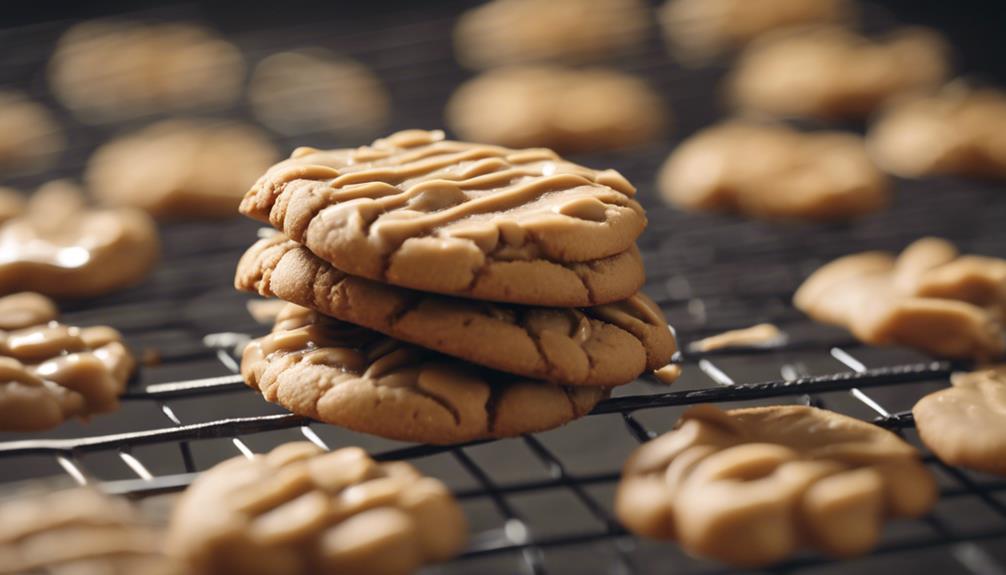Do you find yourself bored of regular nut butters? Prepare to be amazed by a flavorful, creamy, and healthy option – pumpkin seed butter!
Making your own is easier than you think, and the results are absolutely mind-blowing. In this article, we’ll guide you through the simple steps of gathering the ingredients, roasting the pumpkin seeds to perfection, blending them into a velvety spread, and adding your favorite flavorings.
Get ready to elevate your toast game to a whole new level!
Key Takeaways
- Pumpkin seeds are a nutritional powerhouse, packed with protein, healthy fats, fiber, magnesium, and zinc.
- Roasting pumpkin seeds enhances their flavor and makes them easier to blend into a butter.
- Pumpkin seed butter is a great source of plant-based protein and essential vitamins and minerals.
- Proper storage and usage of pumpkin seed butter ensure its freshness and maximize its longevity and versatility.
Gathering the Ingredients
First, gather the ingredients needed to make pumpkin seed butter. Pumpkin seeds are not only delicious but also packed with nutritional value and health benefits. They are a rich source of protein, healthy fats, fiber, magnesium, and zinc.
To make pumpkin seed butter, you will need:
- Two cups of raw pumpkin seeds
- A pinch of salt
- One tablespoon of oil (such as olive oil or coconut oil)
The oil helps in achieving a smooth and creamy consistency. Once you have gathered these ingredients, you can move on to the next step of roasting the pumpkin seeds. Roasting the seeds enhances their flavor and makes them easier to blend into a buttery consistency.
Roasting the Pumpkin Seeds
Once you’ve cleaned and dried your pumpkin seeds, you can start roasting them to bring out their nutty flavor. Roasting pumpkin seeds is a simple process that can be done in your own kitchen. Here are some roasting techniques to help you achieve the perfect batch of roasted pumpkin seeds:
- Preheat your oven to 350°F.
- Toss the cleaned and dried pumpkin seeds with a little bit of olive oil or melted butter.
- Spread the seeds in a single layer on a baking sheet.
- Season the seeds with salt, or add your favorite spices for extra flavor.
Roasting pumpkin seeds not only enhances their taste, but it also offers several health benefits. Pumpkin seeds are a good source of protein, fiber, and healthy fats. They are also packed with important nutrients like magnesium, zinc, and antioxidants.
Incorporating roasted pumpkin seeds into your diet can help support heart health, boost immunity, and promote overall well-being. So, don’t let those pumpkin seeds go to waste – roast them up and enjoy their deliciousness and health benefits!
Blending the Pumpkin Seeds
When it comes to blending pumpkin seeds into a smooth and creamy butter, you have a few options for blenders to use. High-speed blenders, such as a Vitamix or Blendtec, are recommended for their powerful motor and ability to pulverize the seeds into a silky texture.
Additionally, you can enhance the flavor of your pumpkin seed butter by adding various spices and flavorings, such as cinnamon, vanilla extract, or even a touch of maple syrup. Experimenting with different combinations will allow you to create a unique and delicious pumpkin seed butter that suits your taste preferences.
Blender Options for Seeds
There are many blender options you can use to grind up the seeds into a creamy butter-like consistency. Here are some options for you to consider:
-
High-speed blender: These blenders are powerful and can easily break down tough seeds into a smooth butter. They are great for larger quantities.
-
Nutribullet: This compact blender is perfect for making smaller batches of seed butter. It has a strong motor that can handle the seeds well.
-
Food processor: While not as powerful as a high-speed blender, a food processor can still do a decent job at grinding up the seeds. It may require more time and effort, but it gets the job done.
-
Immersion blender: This handheld blender is convenient for small quantities and easy to clean. It may not be as effective as other options, but it can still produce a decent seed butter.
When choosing a blender, it’s important to consider any seed allergies you or others may have. Make sure to thoroughly clean the blender after each use to avoid cross-contamination.
Adding Flavorings and Spices
To enhance the flavor of your seed butter, you can experiment with various spices and flavorings. Not only will this add a delicious twist to your butter, but it can also provide additional health benefits.
One popular option is adding cinnamon, which not only adds a warm and comforting flavor, but also has anti-inflammatory properties that can help reduce inflammation in the body.
Another flavorful choice is vanilla extract, which adds a subtle sweetness to your butter. Additionally, you can try adding a pinch of sea salt to enhance the overall taste.
Other options include nutmeg, ginger, or even a sprinkle of cocoa powder for a chocolatey twist. Remember to start with small amounts and adjust to your taste preferences.
Experimenting with different flavorings can truly take your seed butter to the next level while providing a range of health benefits.
Consistency and Texture Achieved
Achieving the desired consistency and texture is key to making your seed butter enjoyable and easy to spread. Here are some tips to help you achieve smoothness and adjust the thickness of your pumpkin seed butter:
- Roast the pumpkin seeds before blending to enhance their flavor and make them easier to grind into a smooth paste.
- Add a small amount of oil, such as coconut or avocado oil, to help create a creamy texture.
If your seed butter is too thick, gradually add a bit of oil or water until you reach the desired consistency. On the other hand, if your seed butter is too thin, you can add more roasted pumpkin seeds or nuts to thicken it up.
Adding Flavorings and Sweeteners
Adding flavorings and sweeteners can enhance the taste of your pumpkin seed butter. While pumpkin seed butter has a naturally nutty flavor, you can experiment with different ingredients to elevate its taste. If you prefer a sweeter version, consider using sweetener alternatives like honey, maple syrup, or coconut sugar. These options not only add sweetness but also contribute additional depth of flavor.
For a savory twist, you can try adding ingredients like garlic powder, onion powder, or even a pinch of salt. These savory options can complement the natural earthiness of the pumpkin seeds and create a unique flavor profile. Whether you choose sweet or savory additions, make sure to adjust the quantities to your preference and taste as you go.
Now that you have enhanced the taste of your pumpkin seed butter, let’s move on to learn about storing and using it.
Storing and Using Pumpkin Seed Butter
When it comes to storing and using pumpkin seed butter, there are a few key points to keep in mind.
First, let’s talk about shelf life and storage. Pumpkin seed butter can be stored in an airtight container in the refrigerator for up to three months, or in the freezer for up to six months.
Now, let’s move on to culinary applications. Pumpkin seed butter can be used in a variety of ways, such as a spread on toast or as an ingredient in smoothies, sauces, and baked goods.
Shelf Life and Storage
To ensure your pumpkin seed butter stays fresh, store it in an airtight container in the refrigerator. Proper storage is essential for maintaining the longevity of your homemade spread.
Here are some tips to help you store your pumpkin seed butter correctly:
- Keep it in an airtight container: This prevents exposure to air and moisture, which can cause the butter to spoil.
- Refrigerate it: The cool temperature of the refrigerator slows down the oxidation process and helps to preserve the flavor and texture.
- Avoid light exposure: Store the container in a dark place or use an opaque container to protect the butter from light, which can lead to degradation.
- Check for signs of spoilage: If you notice any off smells, mold growth, or changes in texture and taste, it’s time to discard the butter.
Now that you know how to store your pumpkin seed butter properly, let’s explore its culinary applications.
Culinary Applications
Now that you know how to properly store your pumpkin seed butter, let’s explore the various culinary applications of this delicious spread. Pumpkin seed butter can be used in a wide range of recipes, adding a nutty and creamy flavor to both sweet and savory dishes. Here are some culinary techniques and ideas to incorporate pumpkin seed butter into your cooking:
| Culinary Techniques | Culinary Ideas |
|---|---|
| Spread | Use pumpkin seed butter as a spread on toast, bagels, or crackers. |
| Dressing | Make a pumpkin seed butter dressing by combining it with vinegar, oil, and spices for a unique salad dressing. |
| Smoothies | Add a spoonful of pumpkin seed butter to your smoothies for a protein and nutrient boost. |
Not only does pumpkin seed butter enhance the taste of your meals, but it also provides several health benefits. It is rich in essential nutrients like protein, healthy fats, fiber, and vitamins. Additionally, it contains antioxidants that support immune function and may help reduce inflammation. Now, let’s dive into the nutritional benefits of pumpkin seed butter.
Nutritional Benefits
You’ll be pleased to know that incorporating pumpkin seed butter into your diet can provide you with a range of nutritional benefits. Here are some key reasons why you should consider adding this delicious spread to your meals:
-
Plant-based protein: Pumpkin seed butter is a great source of plant-based protein, making it an excellent choice for vegans and vegetarians who may struggle to meet their protein needs. Just two tablespoons of pumpkin seed butter contain around 7 grams of protein.
-
Omega 3 fatty acids: Pumpkin seed butter is rich in omega 3 fatty acids, which are essential for heart health and brain function. These healthy fats can help reduce inflammation, lower blood pressure, and support cognitive function.
-
Vitamins and minerals: Pumpkin seed butter is packed with essential vitamins and minerals, including magnesium, iron, zinc, and vitamin E. These nutrients play vital roles in supporting a healthy immune system, promoting good bone health, and maintaining healthy skin.
-
Fiber: Pumpkin seed butter is a good source of dietary fiber, which can help regulate digestion, promote feelings of fullness, and support healthy weight management.
Incorporating pumpkin seed butter into your diet is an easy and delicious way to boost your intake of plant-based protein, omega 3 fatty acids, vitamins, minerals, and fiber. So go ahead and enjoy this nutritious spread on toast, in smoothies, or as a tasty dip for fruits and vegetables. Your body will thank you!
Troubleshooting Tips
If your pumpkin seed butter is too thick, try adding a little bit of oil to achieve a smoother consistency. Common issues when blending pumpkin seeds can include the butter being too thick or grainy, resulting in an unsatisfying texture. To avoid this, make sure to blend the seeds for a sufficient amount of time to break them down completely.
Additionally, adding a small amount of oil, such as coconut or vegetable oil, can help achieve a smoother and creamier texture. You can also try roasting the pumpkin seeds before blending them, as this can enhance their flavor and make them easier to blend.
Another tip is to add a pinch of salt or a sweetener like honey or maple syrup to enhance the taste. By following these troubleshooting tips, you can create a delicious and smooth pumpkin seed butter.
Conclusion
So there you have it, your very own homemade pumpkin seed butter! By following these simple steps, you’ve transformed plain pumpkin seeds into a creamy and delicious spread that’s packed with nutrients.
Just like a warm embrace on a chilly autumn evening, this pumpkin seed butter will bring comfort and satisfaction to your taste buds.
With its versatility and health benefits, you can enjoy it on toast, in smoothies, or even as a dip for your favorite fruits and vegetables.
So go ahead, give it a try and let the pumpkin seed butter embrace you with its delightful flavor and nourishing goodness.
